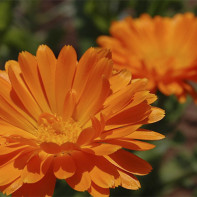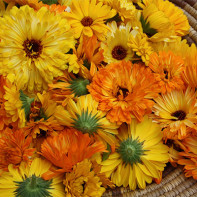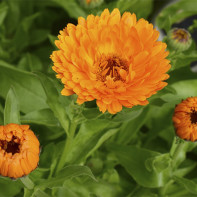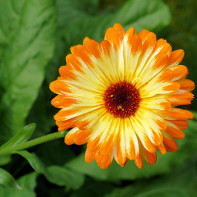Calendula: medicinal properties and contraindications
People call this plant "marigolds", it is grown in flowerbeds and flower beds, almost the whole season decorating the yards with its bright blossoms. Calendula is not just a beautiful flower, it is a universal medicinal plant that helps to cope with dozens of different diseases. The therapeutic properties are confirmed by science, so calendula is included in the pharmacopoeia of different countries.
- Chemical Composition
- What it looks like and where it grows
- Types of
- Harvesting and storage
- Therapeutic properties of marigold
- For Women
- For Men
- In Pregnancy
- When breastfeeding
- For children
- When losing weight
- Calendula in folk medicine
- Diabetes mellitus
- In pancreatitis
- For gastritis
- For bowel
- With constipation
- For gout
- For colitis
- For the liver
- For hemorrhoids
- For cholecystitis
- For angina
- For cough
- For thrush
- For colds
- Otitis
- For cystitis
- For menopause
- Chicken pox
- For dermatitis
- For mastopathy
- Gum inflammation
- Oncology
- For psoriasis
- For prostatitis
- Allergy
- Herpes
- Arrhythmia
- For maxillary sinusitis
- Varicose veins
- Types of medicinal compositions with marigold
- Infusion
- Infusion
- Decoction
- Tea
- Ointment
- Candles
- Calendula-based medicines
- Calendula oil: properties and application
- Cosmetic applications
- Whitening mask
- Skin steaming
- Tonic for problem skin
- Calendula in cooking
- Cheese salad with calendula
- Nalewka
- Seasoning
- Can I give calendula to animals?
- Contraindications to use
- Interesting facts about marigold
Chemical composition
Calendula is one of the most sought-after medicinal plants, you can buy it in every pharmacy. Moreover, it is grown by many people themselves, because it is a universal remedy that can be used both for the treatment and for the prevention of a variety of diseases. The inestimable usefulness of the plant is due to its rich chemical composition. To find out how useful this herb is, it is worth studying its chemical composition.
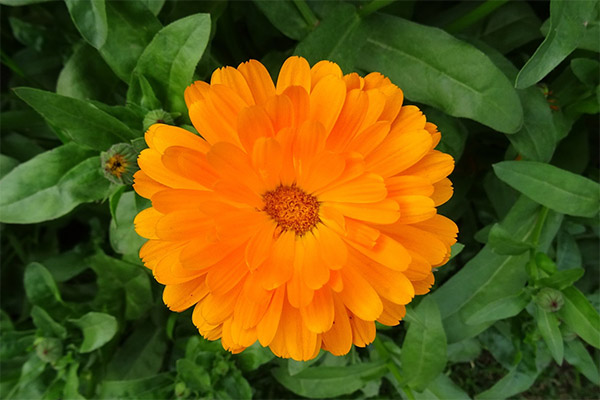
- Flavonoids - plant natural components that have antispasmodic, healing, diuretic and antioxidant action. They strengthen the immune system and have antiviral effectiveness.
- Carotenoids are plant natural pigments that color the inflorescences in a bright orange color. The same substance is found in carrots and pumpkins. Carotenoids neutralize free radicals. The most valuable varieties of these substances are present in marigold in high concentrations - provitamin A.
- Essential oils are also found in marigold, they are effective against pathogenic microorganisms, and are also powerful stimulants, spurring the body to activate regenerative processes.
- Triterpenoids are plant substances that contain acids, they help with gout, have anti-inflammatory effects, affect nerve impulse conduction, in the long term clear the blood vessels and reduce cholesterol levels.
- Sterols are analogues of human hormones, steroidal substances. They dissolve cholesterol, support the liver, and keep the reproductive system healthy.
- Salicylic acid is an organic compound that has antiseptic, anti-inflammatory, analgesic, anti-rheumatic effects.
- Coumarins are active substances that stop the growth of tumors, block the development of viruses and bacteria, and stimulate the immune system.
- Lutein is an organic pigment that supports eye health and normalizes the functioning of the nervous system.
This is not all the active substances that are present in the inflorescences of marigold. Also in this amazing plant are found such components:
- Zinc - important for healthy skin and hair, increasing immunity.
- Potassium and magnesium - to support water-salt balance, heart and nervous system.
- Iron and calcium - for the health of the musculoskeletal system and normal hematopoiesis.
- Copper - for hematopoiesis, hormonal balance and inflammation.
- Selenium - for cancer prevention, stopping the growth and development of abnormal cells, normal functioning of the endocrine and reproductive systems.
- Molybdenum - for healthy teeth, beautiful hair and nails, against infections.
The stems and leaves of marigold are not useless either, but are used many times less frequently in folk medicine. They contain resins and esters, thanks to which the plant can be used as an antibacterial agent and a source of tannins. The seeds of this plant are of high value - they contain fat in large quantities and are used to produce oil with medicinal properties.
What does it look like and where does it grow?
Calendula is a genus of herbaceous plants, perennials and annuals. This genus is included in the Aster family and therefore has similar botanical characteristics. Calendula is officially recognized worldwide as a medicinal plant, so it is often used by pharmaceutical companies to produce drugs.
The botanical characteristics of this plant are:
- height - from 30 to 70 cm;
- green pubescent leaves;
- a rosette of root leaves;
- apical inflorescences, baskets;
- drop-shaped or oval leaves;
- The color of the flowers varies from light yellow to bright orange.
Calendula is propagated by seeds and vegetative methods, but the easiest way to grow it is by sowing. The potential of germination is preserved in the seeds long enough - up to three years. In addition, calendula actively reproduces by self-seeding, so those who grow it in their plot should monitor the maturation of seeds and remove them in a timely manner.
Calendula is widespread mainly in Eurasia, the largest number of varieties grows and cultivates in the European part of the continent. It is a very hardy and unpretentious plant. In southern regions you can observe flowering of this plant even up to frosts. Calendula has pronounced decorative qualities, so it is used in landscape design. This flower is famous for its prolonged flowering, so it can decorate flowerbeds and flowerbeds throughout the season.
Types
According to various data, there are from 12 to 20 species in the genus calendula. Some of the varieties are rare and have no botanical features, so classifiers have had problems identifying these plants. But by far the most common variants, found everywhere, are recognized as three varieties.
- Calendula medicinalis is the most popular species, used for medicinal purposes and grown as an ornamental plant. It is cultivated on an industrial scale. This flower is grown for pharmaceutical companies in regions with good ecology and low radiation levels.
- Calendula field is a wild variety that has the same medicinal properties as the previous species. This plant has smaller flowers and reaches a maximum height of 40-50 cm.
- The third variety is a whole group of subspecies, all kinds of hybrid varieties, which are created for decorative purposes, but are also used in folk medicine.
Calendula medicinalis is a leader in the concentration of active components, positively affecting human health. It is possible to grow it at home on garden plots. For the raw material to be environmentally friendly and harmless, it is necessary to plant flowers away from roads and not to use toxic chemical fertilizers. And without them, calendula grows well and gives abundant flowering, the main thing is to choose a good sunny site and provide the plant with regular watering.
Gathering and storage
For those who do not have the opportunity to collect and harvest medicinal raw materials themselves, every pharmacy sells ready-made, already dried marigold - in paper bags or prepackaged. But if you want to harvest your own raw materials, you must follow these rules.
- Choose an environmentally friendly place for the collection, where there are no factories and enterprises with toxic emissions.
- Only cut inflorescences, and do it before the seeds begin to form.
- The ideal time for harvesting is early in the morning, when the dew has just dried out.
- Do not pick marigolds after rain or heavy watering.
The flowers should be neatly cut with sharp garden shears and placed in a box or in a basket. At home, spread a clean cloth and let the flowers dry naturally for 5-7 days. When the flowers are completely dry, put them in bags or boxes for storage. You can keep the raw materials in glass jars. The recommended period of use - 1 year, but the maximum time you can store herbal raw materials for 2 years.
Therapeutic properties of marigold
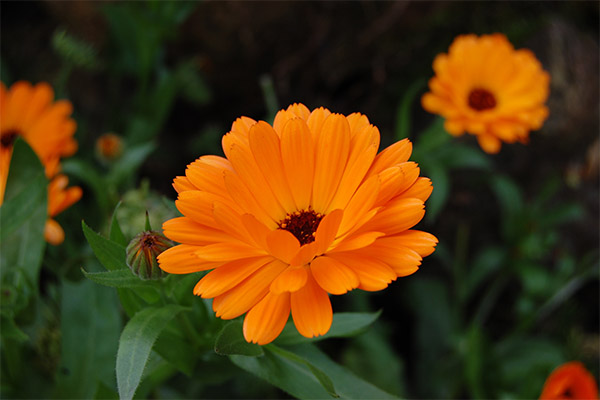
Calendula is a powerful medicinal remedy that can be used for a variety of health problems. Its beneficial properties are so diverse that it can be used for a wide variety of ailments. Here is a general list of medicinal properties:
- immunomodulatory;
- antibacterial;
- antifungal;
- bactericidal;
- antiviral;
- anti-inflammatory;
- sedative;
- antispasmodic;
- analgesic;
- anticancer;
- anticoagulant;
- anti-coughing;
- expectorant;
- anticonvulsant;
- diuretic;
- diaphoretic;
- antipyretic;
- tonic.
In addition, calendula is differently able to influence the human body depending on gender, physiological state and age. Therefore, you need to know what is useful for men and women, how it can affect children's health, as well as what is good in this herb for pregnant and lactating women.
For women
Calendula is useful for women's health, it can normalize the hormonal background and help to cope with a number of diseases of the reproductive system. The plant contains plant hormones, which have a beneficial effect on the reproductive system. It helps to cope with candidiasis, inflammation of the ovaries, infections of the genitourinary system.
Calendula is effective for hormonal disorders that lead to menstrual cycle failures. Also this plant can be used for skin and hair care, it helps to solve most of the problems that worsen the appearance.
For men
Men, too, can appreciate the useful properties of this plant. Calendula helps with infectious diseases of the male reproductive system, strengthens the immune system and protects against most common cancers that occur in the male sex. But it is important to remember that for men, prolonged use of calendula can harm, because it contains phytohormones, the structure and formula are identical to those of women.
In pregnancy
Medics do not recommend the use of calendula for treatment during pregnancy. But this prohibition applies only to the reception of oral remedies based on this plant. If necessary, infusions and ointments can be used externally, to gargle the throat and treat oral problems.
Calendula in pregnancy can be used by women to maintain the beauty and health of the skin. Often due to hormonal disorders, acne and pigmentation appear on the skin. The use of potent chemical cosmetics can be harmful, and a small dose of herbal substances, which will enter the body through the skin, will definitely be safe. So there's no need to worry.
When breastfeeding
Doctors do not forbid the use of calendula during breastfeeding. This plant very rarely provokes the appearance of allergic reactions, but still the internal reception is not recommended. If you need to use herbal raw materials internally, you need to stop breastfeeding for a while. When applied externally, there is no need to stop breastfeeding. Here are the benefits of marigold for nursing women:
- helps with skin diseases;
- Supports the health of the mammary glands (used for compresses);
- Copes with colds (for gargling the throat, inhalations);
- It relieves pain (as a compress).
Calendula can be used internally for inflammatory processes, hormonal disorders, as well as when it is necessary to treat various postpartum problems.
For children
Calendula is one of the few herbs that can be used for children from birth. But the first couple of years it is allowed to use this plant only externally, to treat skin diseases. The plant effectively copes with different types of dermatitis in children, it is used in complex collections for children's baths. In pediatrics, the following properties of calendula are used:
- anti-inflammatory;
- antiseptic;
- regenerative;
- drying;
- anti-allergic.
Calendula helps to cope with the most common childhood problem - sweating. When other means are prohibited, this herb can be used to prepare medicinal baths. After the procedure, the child becomes calmer, the rash decreases, the itching goes away. As a result of inhaling the vapors with essential oils that are contained in calendula, sleep and appetite are normalized.
For weight loss.
Calendula can also be used by those who really want to lose weight without harming their health. This plant helps to normalize the rate of metabolic processes, to cleanse the body of toxins. Calendula effectively stimulates the production of digestive enzymes of all types, so it helps to normalize appetite and establish a diet. When losing weight, calendula is used internally in the form of tea. You can also combine this plant with other herbs that enhance the effect in weight loss.
Calendula in folk medicine
In folk medicine, there are dozens of ways to use calendula. For each individual diagnosis, the recipe for the remedy, the method of taking it, the dosage, as well as the duration of treatment is different. It is important to know how to use this herb correctly in each case to get the maximum benefit from it.
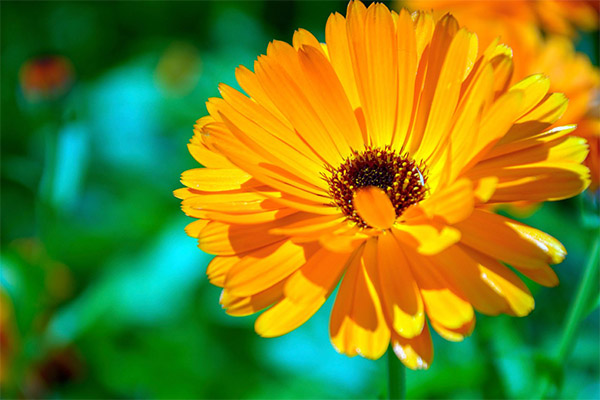
In diabetes mellitus
Numerous studies have confirmed that calendula is effective in the treatment of diabetes. Of course, you can not be cured completely with the help of the herb, but this plant helps to reduce the risk of complications, protects the body from hypoglycemia and hyperglycemia, cleanses blood vessels and stimulates metabolic processes. Diabetics are advised to take tea from calendula flowers twice a day. If there are no contraindications, you can use this remedy for 2 months, and then take a break for the same amount of time and repeat.
The tea is brewed immediately before use. You need to take an incomplete teaspoon of dried calendula inflorescences, steep with a cup of boiling water and soak for 5-7 minutes under a lid. After this you can immediately strain the drink and drink, adding to such a tea sugar substitutes or fructose syrup.
In pancreatitis
Calendula is useful in pancreatitis for three reasons. It stops inflammatory processes, eliminates bacterial microflora, and normalizes the production of pancreatic enzymes. But calendula is forbidden to use during exacerbations, when the pancreas even without stimulation produces too much digestive enzymes.
To eliminate inflammation in pancreatitis, you need to take marigold tea 3 times a day for 3 weeks. It should be brewed just before taking it. When the tea is warm, it should be strained and drunk, and 15 minutes later eat. The tea should be prepared from 1 teaspoon of inflorescences and a cup of boiling water.
With gastritis
With gastritis, you can use calendula to restore normal digestion, prevent the development of inflammation and complications. With hypoacidic gastritis, an alcoholic tincture is used - it should be drunk ½ teaspoon before each meal. You can not worry about the fact that the medication is in alcohol - in this dosage, ethanol has no effect on the ability to drive a vehicle or perform any tasks that require increased concentration.
For gastritis with high acidity, it is better to drink tea or water infusion. Tea can be prepared immediately before meals and immediately drink when infused (3-5 minutes). Infusion is better prepared in advance - brew 250 ml of boiling water with 1 tablespoon of the herb and infuse for 2 hours, drink 50 ml.
For the intestines
In disorders of intestinal peristalsis, inflammation, dysbacteriosis, it is recommended to eat oatmeal brewed with a hot infusion or decoction of marigold. If you eat such a dish for breakfast every day for 2 weeks, you can quickly and effectively cope with inflammation, normalize bowel motor function and normalize the microflora.
Also for the treatment you can use the infusion. With intestinal tumors it is used in the form of a daily enema. In other diseases that are accompanied by acute inflammation, aqueous infusion is used internally to restore the intestinal mucosa. It is taken before a meal for 10-15 minutes to 50 ml. The preparation is very simple - you need to steep 20 grams of grass in 1 liter of boiling water and soak for 2 hours.
When constipation
Chronic constipation can be treated by taking a tincture of marigold on an empty stomach. You need in the morning dilute 1 tablespoon in 1 glass of water and drink 30 minutes before a meal. You can also use calendula oil for constipation, taking 1 teaspoon 2 times a day. The main thing is to follow a diet during treatment, to consume a large amount of vegetables and cereals, to refuse fast food, fatty and spicy foods.
In case of gout
In gout, calendula is used as a powerful source of organic acids and components that can break down uric acid salt crystals. It is most effective to combine external use with ingestion. With gout categorically contraindicated use of alcoholic tincture inside, so use decoction and infusion. You need to take for a month to 100 ml of decoction or infusion 2 times a day, and externally use an alcoholic tincture for compresses.
With colitis
When inflammation of the intestines, the antiseptic, antibacterial and anti-inflammatory potential of the plant is used. Calendula can be used in two ways.
- During the acute stage, drink calendula tea 1 cup 3-4 times a day for 3-5 days.
- When the inflammatory process subsides a little, do enemas with the decoction. Take 100 ml of water for 2 tablespoons of raw materials and boil for 15 minutes.
In chronic colitis is recommended to use calendula tincture for long courses of 4-6 weeks, to drink 20 drops before each meal.
For the Liver
In diseases of the liver, calendula stimulates the blood supply of this organ, and also eliminates the inflammatory process in viral hepatitis. It should be used for long courses of 3-4 months. The first month you can use calendula infusion of 1 tablespoon 3-4 times a day. Then 1.5-2 months to reduce the dosage in half and drink 1 tablespoon 2 times a day, and on the third or fourth month to leave only one reception per day.
Hemorrhoids
With hemorrhoids, calendula relieves inflammation, reduces the size of the nodes, and protects against the appearance of complications. You can use these three recipes.
- Prepare candles from 50 g of pig fat, 2 tablespoons of calendula and 20 g of coconut oil. Boil all the ingredients on low heat for 15 minutes, strain and pour into molds, using cling film or rubber medical gloves.
- Boil the infusion, drain through gauze. The cake used for compresses. The procedure is repeated two times a day.
- Lubricate hemorrhoidal nodes 2 times a day with calendula oil.
It is also useful to combine external use with taking tea from the herb. Drink 1 cup 2 times a day.
In cholecystitis.
Calendula contains bitterness, as well as substances that tone the walls of the gallbladder. Therefore, when using this herbal remedy there is a stimulation of bile production, the motor function of the gallbladder is normalized, which is necessary with cholecystitis. It is necessary to use calendula infusion before each meal, 1 tablespoon with warm boiled water. Prepare the infusion as follows - pour a glass of boiling water 2 tablespoons of herbs and keep under a lid for 20-30 minutes.
When sore throat
Calendula is very effective in the treatment of angina of viral and bacterial etiology. Plant raw materials can be used in the form of alcohol tincture or water infusion. To treat sore throat, you need to use calendula as the basis for preparing solutions, with which you need to rinse your throat.
- Tincture: 1 tablespoon per 150 ml of water, gargle your throat 5-7 times a day.
- Water infusion: 2 tablespoons of the collection in 500 ml of water, gargle your throat 5-7 times a day.
The main rule of gargling is to do it after eating, drinking or taking medicine. It is important that a person does not eat or drink anything after the procedure for 30 minutes.
When coughing
Calendula is used for coughs in the form of tea and alcoholic tincture. The tea should be made fresh before each intake. To recover faster, you need to drink the tea 4-6 times a day. The alcohol tincture should be used to rub the chest. This activates blood circulation, as a result of which the body quickly absorbs the components of the plant. Calendula provides anti-inflammatory, expectorant and antibacterial effects. Essential oils, which are contained in the inflorescences, ease breathing and block attacks of dry cough.
In case of thrush.
With candidiasis, calendula decoction can be used for irrigation. It is important to use exactly a decoction, not an infusion, as boiling kills all germs and minimizes the risk of bacterial infection joining. The decoction should be prepared as follows - take 2 tablespoons of dried inflorescences for 300 ml of boiling water and boil over low heat for 30 minutes. After that, strain the remedy and after cooling, use as directed.
With a cold.
Many times faster to cure a cold can be cured by using calendula tea. You need to brew it 4-5 times a day and drink it with the addition of linden honey. You can prepare a mixture of herbs and brew tea from it. It is necessary to take in equal parts calendula, chamomile, mountain bird's wort and linden. Boil 1 teaspoon each with a cup of boiling water and drink hot. You can boil 1 tablespoon of calendula in 0.5 liters of fat-free milk and drink for a day 4-5 times 100 ml. It is also good to use calendula for symptomatic treatment, to put decoction into the nose when a severe runny nose, gargle the throat, breathe steam to block the inflammatory process in the respiratory tract.
In otitis media.
With exudative otitis media, it is necessary to use an alcoholic tincture - drop 1 drop in each ear, even if the inflammation occurs only in one. Calendula tincture eliminates inflammation, dries the ear and prevents the bacterial infection from penetrating further. If you have purulent otitis media, a strong decoction should be used: drip 2-3 drops in each ear 3-4 times a day. With external otitis media you can use compresses with alcoholic tincture of marigold. In chronic otitis should clean the ears with a cotton swab soaked in calendula infusion, once a day for 30 days.
With cystitis
In cystitis, the antibacterial and anti-inflammatory, as well as the diuretic potential of this plant is used. It is necessary to use it in three ways.
- Boil 20 g of the herb in 2 liters of water, wait until the infusion cools to 45 degrees and use it for a bath 2-3 times a day.
- Use calendula water decoction for douches to eliminate bacterial infection of the urinary tract.
- Inside, take an alcoholic tincture of the plant 20 drops 4 times a day.
Calendula in cystitis stops the inflammatory process, stimulates the body's defenses to fight infection and improves well-being.
Calendula and Menopause
Calendula is rich in plant hormones, so it is good for coping with the symptoms of menopause. It reduces the frequency of hot flashes, normalizes the hormonal background, removes attacks of weakness and dizziness. You can use a combined tincture of marigold and red brush (1 teaspoon 2 times a day), or separately boiled (1 teaspoon of plant material) and drink 3-4 times a day a tea.
With chicken pox
Chickenpox is a disease that usually occurs in children. But often adults who did not have time in childhood to acquire immunity to this virus, get chickenpox. The problem is that there is no effective medicine for it, it is a disease that the body must overcome on its own. Despite this, with chicken pox are used remedies that facilitate the course of the disease and reduce the intensity of symptoms.
The main manifestation of chicken pox is an itchy rash all over the body. And to cope with this symptom can help common calendula. You can use a strong infusion of flowers to wipe the affected areas of the skin or make compresses for severe itching. Alcoholic tincture can be used to wipe blisters that have already burst to disinfect the skin and avoid bacterial infection.
In dermatitis
Dermatitis develops for a variety of reasons. They can be infectious, allergic or neurological in nature. Depending on the causes, different methods of treatment are used, but in any therapeutic complex may include remedies based on marigold. Using the herb for dermatitis can be done in different ways. Here are 3 of the most popular recipes.
- Prepare an oil extract - simmer in vegetable oil (250 ml) 2 tablespoons of calendula for 30 minutes at 60 degrees, cool and strain. Smear the affected areas of the skin 2-3 times a day.
- Prepare a decoction of the herb - pour cold water (500 ml) 20 grams of grass, wipe with a cotton swab over areas of the skin with dermatitis 3 times a day.
- Brew 2 tablespoons of herb 400 ml of boiling water, infuse and cool. Make compresses for 20-30 minutes 2-3 times a day.
Already after the first use, you can notice positive effects. For a complete recovery, you need to use calendula for 5-7 days.
With mastopathy
With mastopathy, you can use infusion of marigold orally, you need to brew 50 g of herbs 1 liter of boiling water and drink 3 times a day to 150 ml. The remainder of the infusion should not be discarded, it should be collected in a clean bandage or gauze and used for compresses - put on the sore breast once a day for 30-40 minutes.
With inflammation of the gums
From inflamed gums, calendula can be used only if there is no bleeding, otherwise the plant can aggravate the condition and provoke even more bleeding. When inflammation of the gums a spirit tincture is used. It is necessary to dissolve 1 tablespoon of tincture in a glass of clean boiled water and rinse your mouth 3-4 times a day for 1 week.
Oncology
Calendula contains substances that can block the development of cancer cells and destroy some varieties of cancerous tumors. Use calendula to fight malignant tumors is allowed only as part of comprehensive therapy - it will not replace cancer pills.
When oncological diseases of the reproductive system in women use calendula suppositories vaginally, as well as drink decoction of the herb 150 ml 2 times a day. With other types of cancer, only an infusion of 50 ml 2 times a day before meals is used. The infusion should be prepared in a thermos for 4-6 hours, infusing 20 g of grass with 50 ml of boiling water.
With psoriasis
With psoriasis, the most effective dosage form is an oil extract. Also a fatty oil made directly from the seeds of the plant is used. The oil extract is used for rubbing in the affected areas of the skin 2 times a day for 14 days. It can be used once, if the aggravation began. Inside you should take 1 teaspoon of tincture 1 time a day. Calendula oil is also used externally for rubbing and compresses.
With prostatitis
It is quite simple to cure prostatitis with the help of marigold. It is used in the form of an aqueous infusion. If the problem has become chronic, you need to drink a water infusion of marigold for 30 days 2 times a day. In acute inflammatory process in the prostate gland, it is better to use an infusion of 100 ml every 3-4 hours. It can be prepared from 20 g of herbs and 700 ml of boiling water, kept in a closed container under a lid for 2 hours.
With allergies.
All kinds of skin allergic reactions are treated according to the same scheme as dermatitis. The following remedies are used for wiping:
- aqueous decoction;
- alcoholic tincture;
- oil extract;
- ointment.
You can prepare a multi-component ointment for the treatment of allergic rash. You need to take 20 g of chamomile, 30 g of calendula and 10 g of succession. All of this boil in 300 ml of vegetable oil over low heat for 20 minutes. After that, let the ointment cool, strain it and pour it into a jar for storage. Use twice a day.
When herpes.
Sores on the skin and mucous membranes with herpes should be treated with an alcoholic tincture diluted with boiled water in a ratio of 1:1. You can also moisten a cotton pad in the oil extract and apply it for 15-20 minutes. Calendula blocks the development of the virus, dries and accelerates tissue regeneration in herpes.
In Arrhythmia.
Calendula is one of the popular heart herbs and can be used to normalize heart function. In arrhythmia it is recommended to block an attack by taking 1 teaspoon of calendula tincture orally. The tincture should be drunk with plenty of water.
In the long term, the plant can help to cope with the disease. You need to boil 1 liter of boiling water with 2 tablespoons of flowers and drink, when cooled, 100 ml 2 times a day.
When maxillary sinusitis.
In maxillary sinusitis, calendula tincture is used for compresses. It is necessary to moisten small pieces of bandage in the remedy and apply to the area of maxillary sinuses for 30-40 minutes. It is also useful to use the infusion internally - drink 100 ml 3-4 times a day when exacerbations occur. You can put a decoction of the plant into the nose for 2-3 drops 2 times a day.
With varicose veins
Calendula is one of the most effective plants for treating varicose veins. The inflorescences of this plant can be used fresh. They should be minced through a meat grinder, pour honey, insist 1 hour and use the resulting squash for compresses on painful areas of the skin. You can also use calendula oil - it should be applied daily to the affected areas before going to bed. You can use it twice a day if you do not need to go anywhere. It is important to be at rest after applying the oil.
Types of medicinal compositions with marigold
Calendula medicines can be prepared in different ways, depending on what disease needs to be cured. Also, when choosing a recipe, individual characteristics of the body are taken into account. For example, with liver disease, hypertension or diabetes mellitus, it is strictly forbidden to use remedies prepared on vodka or alcohol.
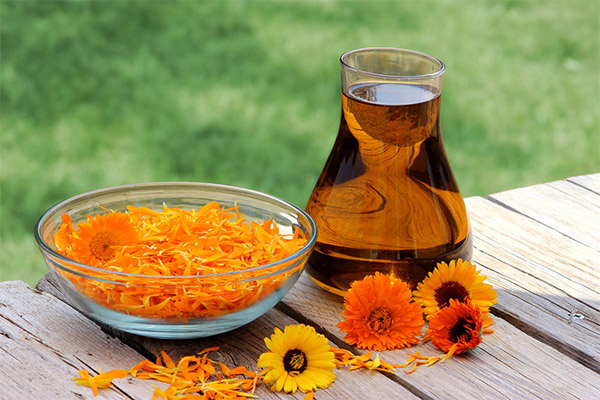
But with some diseases, water infusions are ineffective, so you need to choose a recipe depending on the characteristics of the body, the diagnosis and personal preferences. Some people find it easier to drink tea than a spoonful of the tincture, and some - drip 20 drops of the alcohol extract on sugar, because the water infusion is quite bitter.
Infusion
Preparing an aqueous tincture is very easy - there are 2 ways of preparation. The first method uses boiling water (600 ml) and 2 tablespoons of the collection. The infusion is better prepared in a container with a lid, soaking for 2 hours, and then filtering. It should be stored in the refrigerator and drink 50 ml.
The second method of preparation allows you to get a more concentrated drug. It is necessary in a thermos to pour 500 ml of boiling water 2 tablespoons of grass and leave for 5-6 hours. After that, strain the infusion and drink 50-60 ml before meals.
Tincture .
Prepare a tincture can be made from 100 ml of alcohol and 1.5 tablespoons of dry raw materials. You need to keep the tincture in a dark place for 3 weeks. Approximately every 3-4 days it is recommended to shake the tincture - this will make it more concentrated. After 3 weeks, you can already strain the remedy, pour it into a glass bottle and store in a dry, dark place at a temperature not exceeding 25 degrees. The maximum duration of use of such a remedy - 1 year.
You can prepare calendula tincture not on alcohol, but on vodka or moonshine. But in this case the proportions are slightly different. For each 100 g of vodka, you need to take 2 tablespoons of raw materials. For 0.5 liters take a glass of dried herbs, pour vodka and incubate for 2 weeks in a dark place, and then strain and pour into a container that will be convenient for the use of the remedy.
Decoction
Prepare a decoction can be made from dried and fresh inflorescences of marigold. But it is better to use dry raw materials, since it has a higher concentration of useful substances. The decoction is prepared from 20 g of grass and 1 l of water. Need to boil the cure in a steam bath for 15-20 minutes, and then cover with lid, wrap tightly with a blanket and leave for a couple of hours. Ready decoction, when it is infused, strain and store in the refrigerator.
Tea
Calendula tea is a universal remedy that helps with a variety of ailments. Its main advantage is that it is easy to prepare. Calendula tea can be taken for therapeutic purposes and for prevention. To prepare such a medicine, you need to pour 1 teaspoon of grass in a cup 250 ml of boiling water and soak for 5-7 minutes, covering the container with a lid. Strain the tea and drink it, you can add honey and sugar.
Calendula tea can be prepared in other ways, for example, pour 2 tablespoons of inflorescences into a teapot for brewing, pour boiling water over them and use as a brew. It is also recommended to pluck fresh flowers and add them to tea. This plant can be mixed with black or green tea, it will make the drink more useful, as well as saturate it with a delicate floral aroma.
Salve
It is possible to prepare a therapeutic ointment from calendula at home. There are several popular recipes. In the first one, olive oil is used as a base. It is necessary to take a glass jar of 0.5 l volume, pour dry florets so that they half fill the container. After that, pour heated vegetable oil to the top and close the lid. Insist the ointment for 2 weeks, keeping the container in a dark place, but warm. After 14 days, strain through a sieve and store in the refrigerator, using as needed.
The second version of the recipe - take 400 grams of pork fat without salt or any additives, melt it and pour there 4 tablespoons of dried calendula florets. Protect in the oven at 70-80 degrees for 20 minutes and strain. Store the remedy also in the refrigerator.
Candles
In folk and traditional medicine, suppositories for rectal application made on the basis of calendula flowers are very popular. You can buy them in a pharmacy or make them yourself. The recipe is quite simple, you need the following ingredients:
- 50 ml of calendula oil extract;
- 5 g of beeswax;
- 5 g of cocoa butter.
You need to mix the ingredients and heat to 60 degrees, and then pour into molds and use as directed. The candles can be used not only rectally, but also vaginally to treat various infectious diseases of the reproductive system in women.
Pharmaceutical preparations based on marigold
Pharmaceutical companies have long used the therapeutic properties of marigold in their preparations. There are more than two dozen pharmacy remedies that include an extract of this plant. The purchase of such remedies facilitates treatment, as it eliminates the need for self-preparation and preparation of medicines. Ointment (for the treatment of the skin), tincture (to wipe the skin and ingestion), suppositories (for insertion internally) and dried raw materials (for preparing medicinal compositions at home) - the most common forms of pharmaceuticals based on marigold, which can be purchased without a prescription.
Calendula oil: properties and uses
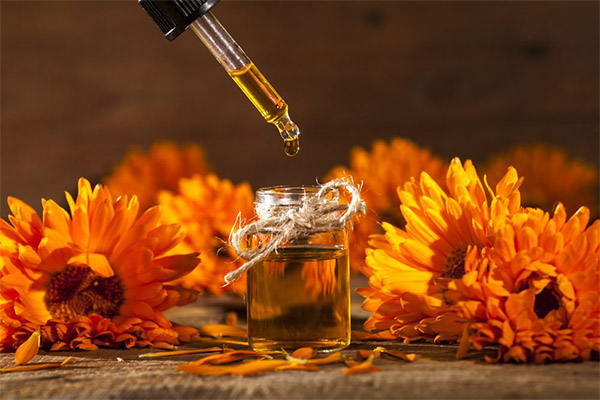
Calendula oil is an effective remedy for the treatment of skin diseases. It is also widely used in the treatment of varicose veins, hemorrhoids, with abscesses and wounds, for recovery after surgery. The oil is also used in cosmetology for the preparation of grooming products and cosmetics. This medicinal product has the following properties:
- eliminates inflammatory processes;
- disinfects;
- normalizes the rate of cell regeneration, heals;
- softens the skin;
- eliminates pain and itching.
The oil can also be used for stomatitis and gum disease - it is smeared on the mucous membranes of the mouth 2-3 times a day. When varicose veins are applied oil compresses and bandages to restore capillaries and prevent the development of thrombosis.
Cosmetic applications
In cosmetology, the medicinal properties of marigold are also used. This plant is excellent for the care of oily and problematic skin, it can be used to restore dry and sensitive dermis, depending on the situations. There are 3 popular recipes that can be used for beauty and skin health.
Bleaching mask.
Since ancient times, calendula flowers have been used to remove excessive pigmentation on the skin of the hands and face. You can use the juice of the plant to prepare a mask to whiten the skin. Apply the juice of the plant in its pure form with massaging motions on the areas of the skin where there are pigmented spots. Wash off after 10 minutes. You can mix calendula juice with lemon juice and tea tree essential oil (1-2 drops).
Skin steaming
If the pores very often accumulate skin secret, which causes the formation of black spots, you need to perform a fairly simple procedure once a week - boil 2 tablespoons of calendula flowers and hold your face over the steam until the liquid cools. After that, you can use a gel or scrub for deep cleansing of the face - it will remove residual fat from the steamed pores, and the skin will be many times clearer. The anti-inflammatory properties of the plant will help prevent inflammation.
Tonic for problem skin
If pimples often appear on the skin, and the T-zone is shiny from excessive secretion of skin glands, you can use an alcoholic tincture of calendula 70% and the juice of the aloe tree. You need to mix 60 ml of tincture and 2 tablespoons of juice, shake and wipe the skin after washing.
Calendula in cooking
Calendula is often used in cooking. This plant gives dishes a special flavor and aroma. For those who want to diversify their menu, there are several interesting recipes.
Cheese salad with marigold
To prepare it, you will need a cheese assortment - 200 g. You can take any kind of cheese, no more than three. You should grate cheese, add 50g of shredded calendula florets and a bunch of chopped green onions. Dress the salad with olive oil with mustard seeds and lemon juice.
Infusion
Calendula can give a special flavor to alcoholic beverages and reduce the harmful effects of alcohol on the body. This nalewka has a delicate flavor and aroma. To prepare the drink you should boil for 5 minutes in 200 ml of water 2 tablespoons of calendula flowers and 1 teaspoon of peppermint leaves. Then strain the broth and add 1 cup of sugar, simmer for 5 minutes. When the syrup has cooled, mix it with 700 ml of vodka, shake and leave in the fridge for 24 hours. Serve when chilled.
Seasoning
You can prepare a seasoning from the flowers of calendula, which can make any dish as useful and delicious as possible. It is necessary to dry in a dryer or oven at 40 degrees fresh flowers at the peak of flowering. It is better to choose the largest and brightest inflorescences, they have the most carotenoids. Grind the dried flowers into a powder with a coffee grinder, or put it in a cloth bag and beat it with a rolling pin, and then sift through a sieve. Add the dry powder to first courses, use to meat and fish, to pilaf and salads.
Can I Give Calendula to Animals
Calendula is effective not only in the treatment of human diseases. It can also be used for animals. Calendula is effective for treating various wounds - they can be treated with a tincture. Calendula water infusion is an indispensable remedy for eye diseases. Small puppies and kittens can use the water infusion for the prevention of eye pathologies. Also calendula can be used for gastrointestinal diseases in cats and dogs. This plant stimulates appetite, eliminates inflammation, normalizes digestion.
Contraindications to use
Despite the fact that calendula is a natural therapeutic agent, it can quite often cause harm to health if used in the presence of contraindications. This herb can be dangerous for conditions such as:
- bleeding;
- Allergies to plants of the Aster family;
- Ulcer disease;
- pregnancy and breastfeeding;
- tuberculosis;
- hypotensive disease.
Calendula is used with caution in various heart diseases. This plant can lead to arrhythmias in people with congenital or acquired heart defects. It is also not recommended to use calendula frequently for thrombosis because it is a strong blood thinner and can worsen the circulatory system.
Interesting Facts about Calendula
Calendula has been used in non-conventional medicine for several thousand years. During this period of time, experts have already managed to study the features of this plant. There are many curious facts that are associated with this flower.
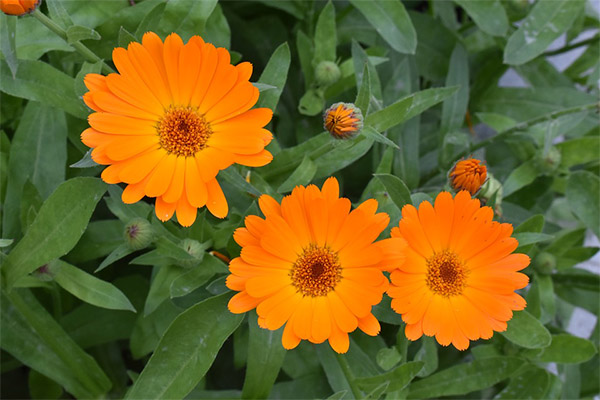
- In Slavic countries, the plant is rarely called marigold, here it is more known as "marigolds". This name appeared to the flower because of the shape of the seeds - they look like a cat's claw.
- In European countries, this flower is often called Maria's gold.
- In Chinese medicine, marigold has been used for the longest time, there this flower is considered one of the symbols of longevity.
- Gardeners plant calendula all around the perimeter of the plot and use it as a border for beds when planting nightshade crops. Such trickery provides protection against Colorado potato beetles.
- Since ancient people could not explain the medicinal properties of this plant, they believed that it had a magical effect and scared away evil spirits that provoke disease.
As you can see, calendula is a universal medicine. If used properly, this flower can serve not only as a garden decoration, but also as a powerful therapeutic and preventive agent!
«Important: All information on this site is provided solely for informational purposes only. Before using any recommendations, please consult with a health care professional. specialist before using any of the recommendations. Neither the editors nor the authors shall be liable for any possible harm caused by materials."

